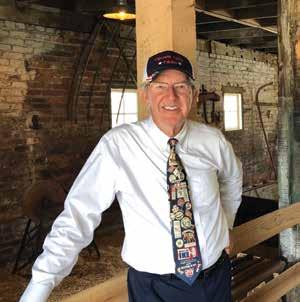
3 minute read
Message from Mayor Richard L. “Ike” Stage
Treasuring the Stories of our Hometown Visionaries
In May, we held a ceremony to officially open the Park Street extension, now terminating at Demorest Road to the west and the entrance of Breck Community Park. Originally named School Street, Park Street connects much of our City’s history and some of my favorite local stories, starting with the Grant-Sawyer Home to the east at Haughn Road.
Six generations of one family occupied the property, the first of whom was a widow named Catharine Grant, who lived there with her six children. Her husband, Hugh Grant Sr., moved his family to Ohio in 1805, and they are considered the original settlers of Jackson Township, acquiring approximately 400 acres in the area that eventually became Grove City. Grant suffered an untimely death within a year or so of arriving, and it was Catharine who persevered through unimaginable circumstances to create the homestead of their dreams.
I’m certain she could not have imagined their family would be the start of something so significant. Over the next 40 years, at least 27 other families would settle in the area, including William Foster Breck (who founded Grove City) and his wife, Elizabeth. The Breck family moved here after acquiring 273 acres of land neighboring the Grant property. Elizabeth’s family had previously owned the property as well as nearly 800 additional acres to the west.
At that time, Park Street was little more than a wide, cleared trail best traveled when dry or hardened by winter, and for the most part it ended at the Columbus and Harrisburg Turnpike (U.S. 62/Broadway). But Breck saw something more. He built a home for his family along the turnpike, set aside 15¼ acres of land for his vision, platted 19 lots and named the village Grove City by 1852.
Within a few short years, new families moved to the area, church congregations were formed and new businesses arrived, including a brick and tile factory started by Breck. A hotel and saloon – now Plank’s on Broadway – was built on the corner of Park Street and the turnpike, which had been improved to gravel and logs as stagecoaches were traveling the road more frequently. Breck also donated land along Park Street where the first village school was built in 1853.
Breck was said to have been a generous man with a desire to grow and improve the community. Unfortunately, he did not live to see Grove City become a chartered village in 1866 as he had an accident that caused his untimely death just two years before.
This brings me to another interesting story in Grove City’s history. A.G. Grant (Hugh Grant’s grandson) was just 12 years old when Breck platted Grove City. As he grew older, Grant became quite the businessman and by the age of 24, had traveled to California to try his hand at goldmining and returned to continue operating a mercantile, a sawmill and other enterprises. By 1889, Grant added land development to his business ventures and, having obtained a significant amount of land west of the turnpike, platted what became Grove City’s first sub-division, the Beulah Mayor Stage, standing in the recently renovated Relieffe Grant Addition. Historical documents barn at the Grant-Sawyer Home. indicate Grant intended the new development area be its own town, named after his daughter Beulah Grant Campbell. It’s interesting to think there could have been two separate towns in the area that is now Grove City. Our hometown history is filled with stories like these. As we celebrate the 170th anniversary of Grove City’s founding by William Foster Breck in 1852, I encourage you to stop by our historical sites and the Grove City Welcome Center and Museum or visit the Southwest Franklin County Historical Society website at www.grovecityohhistory.org to learn more. We will announce additional anniversary celebration events to be held in September and look forward to sharing more historic stories with the community. Mayor Richard L. “Ike” Stage


